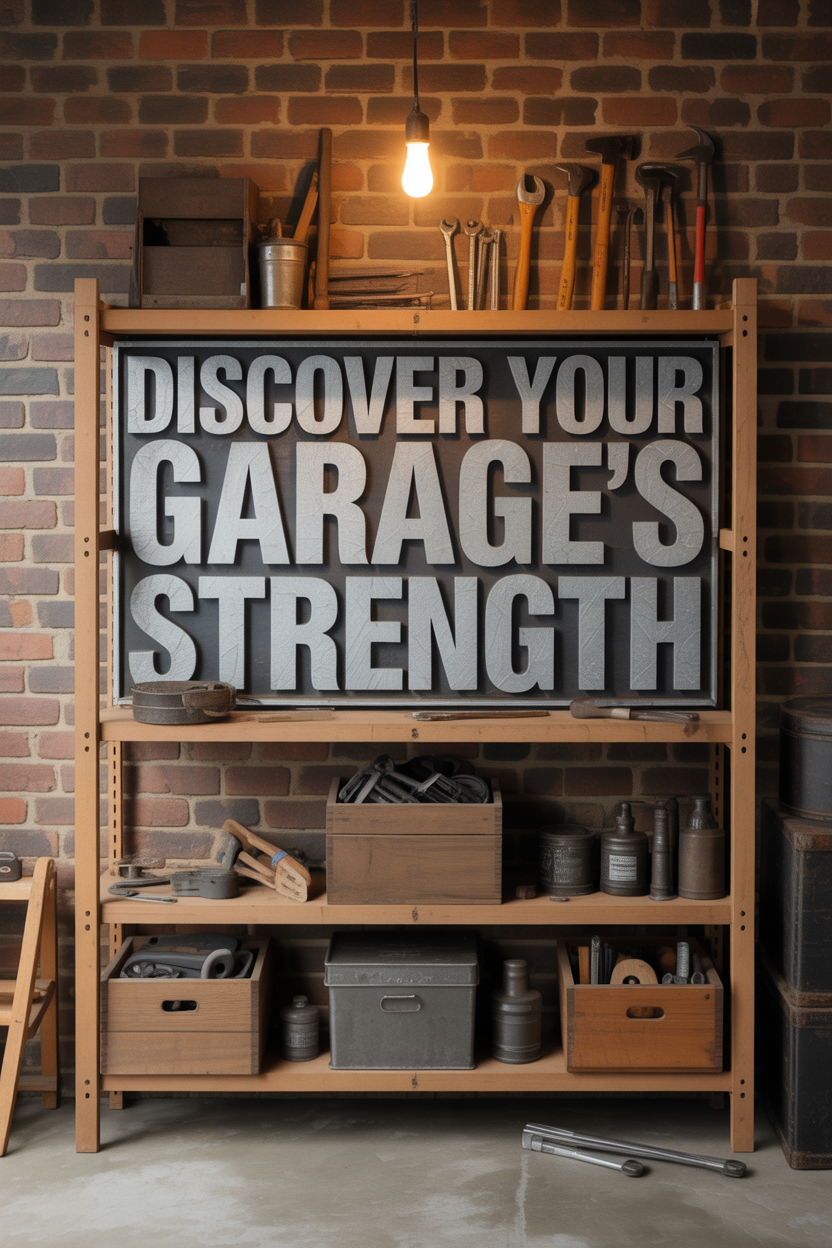How Much Weight Can a Garage Shelf Actually Hold?
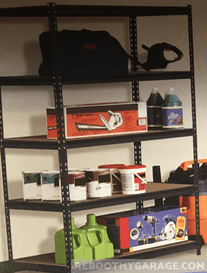
Reorganizing your garage often means dealing with a random assortment of items, some of which are surprisingly heavy. From bulky snow tires on rims to bags of garden soil and fragile keepsakes, you need a storage solution that is both safe and space-efficient.
So how much weight can a garage shelf hold? The capacity varies dramatically, from 100 pounds for a light-duty shelf to an impressive 2,000 pounds per shelf for industrial-grade units.
The key is knowing what to look for, as capacity is determined by the type of shelf and the quality of its construction and installation. Always start by checking the manufacturer’s stated weight limit before you buy to ensure you get the right fit for your needs.
Consumer-grade floor shelving units often hold 800-1,000 lbs per shelf, while heavy-duty and industrial racks can support up to 2,000 lbs or more. Wall-mounted shelves typically support between 100-400 lbs per shelf, though some high-strength systems can hold much more. Lastly, overhead racks are generally rated for 400-600 lbs total, but this weight must be distributed across multiple ceiling joists.
The Foundation: Freestanding Floor Shelving Units

A shelving unit that sits on your floor is the most basic and common solution for garage storage. Generally, you don’t need any tools to assemble them; you just put it together, load it up, and you’re done.
There are a few considerations, like how big your stuff is and how much it weighs. The Edsal MROP3618W5B Steel Storage Rack available on Amazon is a great option that comes in both a 36” and a 60” width.
Both sizes are 18” deep and 72” tall with 5 shelves. Each shelf is rated to hold an impressive 1,000 lbs each, making them perfect for heavy-duty storage needs.
Pros and Cons of Floor-Based Racks

While floor shelving units offer a sturdy solution at a reasonable price, they aren’t without their downsides. The four vertical posts that support the structure can get in the way of storing oversized or awkward objects.
The shelving is often made of wire mesh. This can cause smaller items like stray screws to fall through or spray cans to tip over easily.
A significant drawback is that you are still using valuable floor space, which can make a garage feel cluttered. The area under the bottom shelf can also become a hard-to-clean dust trap over time.
Finally, if your garage floor is not perfectly level or the legs are uneven, the shelves can wobble. This creates an annoying and potentially dangerous hazard.
The pros, of course, are that it can be a relatively inexpensive solution that is easy to assemble. If you move or your needs change, taking them apart is also quick and easy. If your needs are simple and you don’t feel like installing something, this is the way to go.
Go Vertical: Reclaim Your Floor with Wall-Mounted Shelves
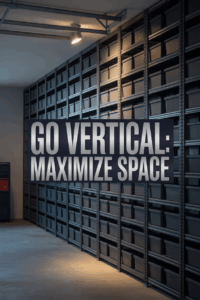
Hanging your storage system on your wall is the next logical step to getting items off the floor. This approach is a bit more “do-it-yourself,” but it’s still very doable for most homeowners.
You’ll need a few common tools, but don’t feel intimidated—you’ve got this. Generally, you’ll need a pencil, tape measure, a power drill with bits, a screwdriver or socket wrench, and a level.
Most importantly, you will need a stud finder, as this tool is critical for a safe and secure installation. A step ladder is also highly recommended if you’re installing shelves higher than you can comfortably reach.
Getting heavy items off your garage floor not only creates more usable space but also protects your belongings from moisture and pests.
What Are the Best Heavy-Duty Wall Shelves?

There are a number of good quality wall shelf systems available. These can range from units like the HyLoft 00777, holding 150 lbs across 36 inches, all the way to the Rhino Shelf system.
The Rhino Shelf is a whopping 33.5” deep and can hold up to 650 lbs across a 48-inch section. I was so impressed by this system that I wrote a whole breakdown of the Rhino Shelf here.
The DIY Rhino Shelf is my top pick for heavy-duty wall shelves. They come in a variety of sizes so you can pick the one that best suits your needs.
With the exception of the Rhino Shelf, many other wall-mounted units have wire shelves, making it easy for things to fall through, and they aren’t terribly deep. The reason for these drawbacks is simple economics: wire mesh is strong yet light for shipping, and 18 inches is about as far as you can get with inexpensive materials.
The Secret to Strength: Proper Wall Shelf Installation
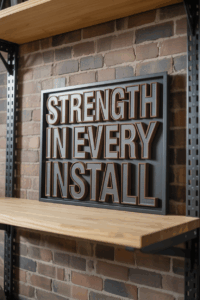
With any wall-mounted system, you must attach it to the studs in the wall to allow it to hold significant weight. Attaching only to drywall is a recipe for disaster, as it simply cannot support heavy loads.
Any good manufacturer will provide the necessary hardware, usually 3.5” lag bolts, to secure the system directly into the studs. Understanding how shelf weight capacity works is key to a safe installation.
The Rhino Shelf system is different because you are paying for incredibly strong brackets that extend out twice as far (33.5”) as ordinary shelves. That’s far enough to hold a 35-gallon storage container lengthwise, a 50 lb. bag of topsoil, or even truck tires.
The shelf itself is made of 2×4 lumber that you provide, which makes perfect sense. 2x4s are cheap, very strong, and any home improvement store can cut them to the exact length you need. Best of all, you can then hang hooks, bike racks, and other accessories from the bottom of the shelf, which offers incredible versatility.
Specialized Storage: Taming Tools and Garden Implements
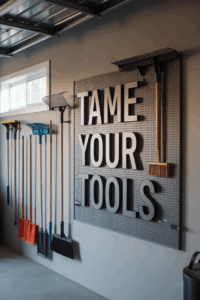
If you have a house, you almost certainly have garden implements like rakes, shovels, and brooms. Even if they’re just aspirational, they need a home other than leaning in a corner.
Decades ago, the go-to method was drilling a hole in the handle and hanging tools from a nail. While that method works, today’s options make organizing tools much easier and cleaner.
Check out modern pegboard or slatwall systems like Holeyrail (Amazon link). These systems offer customizable hooks and holders for a clean, organized look. If you have a workbench, you should have some kind of tool organization to keep your workspace efficient.
How Should I Store Hazardous Materials and Chemicals?

One thing I highly recommend, especially if you have children, is a lockable cabinet for hazardous materials. Use a dedicated cabinet to lock up all your toxic, flammable, and otherwise not-safe-for-children liquids and powders.
This simple step keeps these dangerous items contained and off open shelves where they could fall, spill, or be accessed by curious kids. I wrote about how to safely store chemicals in this article.
According to the National Fire Protection Association (NFPA), proper storage of flammable liquids is a critical safety measure in any home.
Protective equipment such as goggles, gloves, and masks also deserves a good home. We wrote an article about how best to store these important items so they are clean and ready when you need them.
Overhead Ceiling Storage: Unlocking Your Garage’s Hidden Real Estate
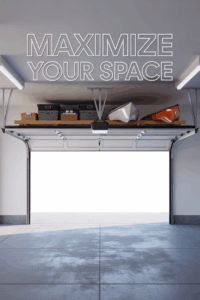
This solution requires the most planning and may even need a second person to implement. But using your ceiling is a fantastic way to store items that are only needed occasionally, like holiday decorations or camping gear.
You can find our Ceiling Storage Buyers Guide here for more options. Platform racks like the Fleximounts System on Amazon can hold up to 600 lbs by spreading the load across multiple ceiling joists.
For an even more convenient solution, consider the Auxx-Lift, a motorized ceiling-mounted shelf system. It’s a real back-saver, but it needs a little room, more planning, and probably help to install.
Other popular options include pulley strap systems to hang things like kayaks or other bulky but lighter items. The only ceiling pulley we recommend at this point is the Store Your Board Hi-Lift due to its safety and reliability.
How Do I Safely Install Ceiling Racks?
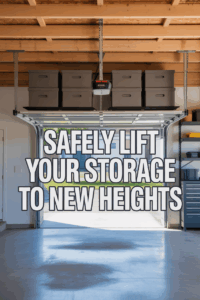
Before installing anything on your ceiling, carefully consider your safety and the structural limits of your garage. Your back is a primary concern, so be extremely careful when lifting heavy items overhead.
Measure twice, install once. Pay special attention to garage door clearance, including the path of the door, handles, and the opener mechanism itself.
Remember that ceilings will hold considerably less weight per joist than walls. You must spread the load across joists, not along them. For a more detailed guide to installation, see this step-by-step article from Family Handyman.
Ensure you have enough room to span the rack across multiple joists. Always check the specifications of the system you are buying and confirm that your joist spacing is compatible. And always use that stud finder—you definitely don’t want to hang anything from just the drywall.
What’s the Best Way to Store Tires and Wheels?
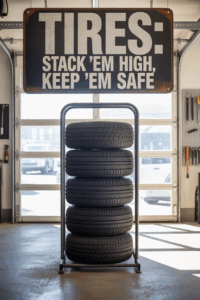
Tires are one of the heaviest and most awkward items to store in a garage. A set of four tires mounted on steel rims can easily weigh over 200 pounds, requiring a seriously robust shelving solution.
Freestanding industrial racks are an excellent choice, as a single shelf can often support 1,000 lbs or more. This allows you to stack two sets of tires without any concern for weight.
A heavy-duty wall-mounted shelf, like the Rhino Shelf, is another fantastic option. Its 33.5-inch depth is perfect for holding tires, getting them completely off the floor and out of the way.
Avoid standard consumer-grade wall shelves or ceiling racks for this task. Their weight limits are often too low for the concentrated weight of a tire stack, creating a significant safety risk.
Your Garage Shelving Action Plan
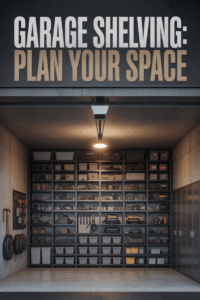
Hopefully, this guide has given you a few things to think about before you start your project. The most important step is to assess your items and measure your space before you buy anything.
Ask yourself what kinds of things you need to store. Are they heavy, bulky, small, or a mix of everything? This will dictate the type and strength of the shelves you need.
Consider what you need access to on a regular basis versus seasonally. Items used less frequently, like holiday decor, are perfect candidates for high wall shelves or overhead storage.
Are there specific solutions that would work best for your hobbies? Specialized racks for balls, kayaks, or garden tools can make a huge difference in staying organized.
Always make sure there is enough room for the car(s) and for you to get in and out of them comfortably. Take the garage door’s path of travel into account, including any handles and openers that might interfere with shelving.
Think of your future needs. Will your storage system be able to adapt as your family grows or your hobbies change? Choosing a modular or adjustable system can save you from redoing your work later.
Most importantly, always check the manufacturer’s load limits and follow installation instructions to the letter to ensure a safe and secure setup.


